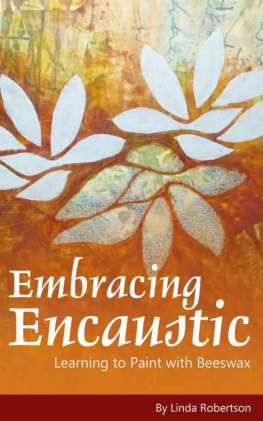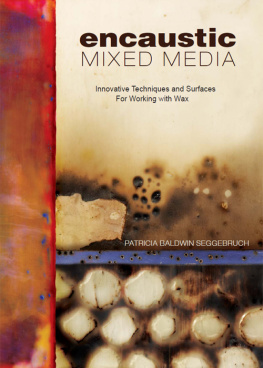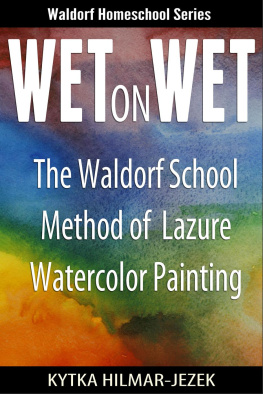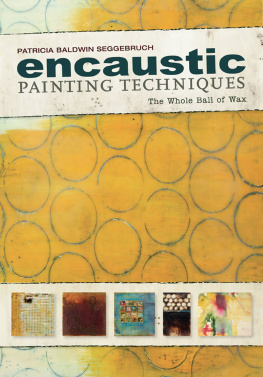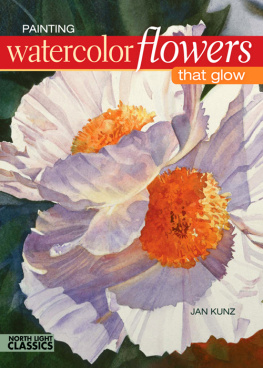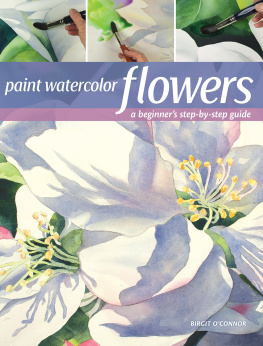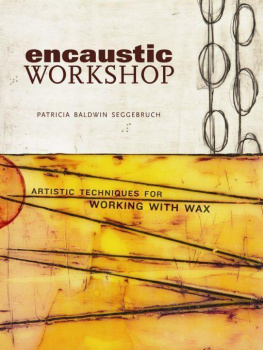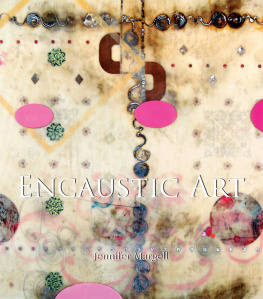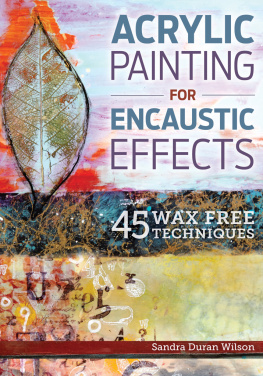Praise for Embracing Encaustic
You really knocked my socks off! The paintings in your book are beautiful and above all there is clarity. You dont leave out basic information that can leave the reader stymied. It was the bane of my search to find a book that wrote clearly HOW to do this, but you have succeeded. The color and richness of the pictures not only illustrate the points but they inspire! BRAVO.
Claribel C., California
Congratulations on the publication of your wonderful book! I am so impressed and well, just wowed, by all the information youve included and by the breathtaking art examples. I feel a little humbled realizing that I have just begun to tap the possibilities of encaustic, but also very, very inspired! Congratulations on a gorgeous book and thanks for sharing your information, knowledge, and vision!
Serena B., Oregon
I received your book today and it is outstanding. I have been looking for a book that simply gave instructions, techniques, and ideas and your book fulfilled all of my expectations. Thank you so much!
Brenda A., Florida
Copyright
Embracing Encaustic: Learning to Paint with Beeswax
Copyright 2008 by Linda Robertson
Hive Publishing
All rights reserved. No part of this book may be reproduced by any mechanical, photographic, digital or electronic process, or in the form of a photographic recording, nor may it be stored in a retrieval system, transmitted, or otherwise copied for public or private use without the written permission of the publisher.
Author: Linda Robertson
Publisher: Hive Publishing, embracingencaustic@gmail.com
Cover Design: Linda Robertson
Cover Image: Songs Never Cease (detail),
48 36 in., encaustic and mixed media, by Linda Robertson
Editor: Elizabeth McDonald
Revised 3rd Edition
1st Printing, 2008
Disclaimer: The author has made every effort to insure that all instructions given in this book are accurate and safe, but cannot accept liability, whether direct or consequential and however arising. If you are pregnant or have any known or suspected allergies you may want to consult a doctor about possible adverse reactions before performing any procedures outlined in this book. The techniques and materials in this book are not for children.
Digital book(s) (epub and mobi) produced by Booknook.biz.
Table of Contents
Introduction
Encaustic is the art of painting with beeswax mixed with colored pigments and resin. This mixture is applied hot then fused with heat to bond each layer together. This type of painting has a long history dating back some 3,000 years to the Greeks working in Egypt. In fact, the Greek word Enkaustikos, meaning to burn in, refers to the fusing process and is the root for the modern word encaustic that we use today. I tell my students its the oldest form of painting youve probably never heard of. Until now.
Greek shipbuilders used to seal their wooden boats with beeswax to make them more waterproof, and eventually started adding pigment to the mixture to add words and images. The same technique was eventually used on flat wood panels that became popular as funerary portraits, the most famous of which are the Fayum mummy portraits. These can be found in important museum collections around the world including the Louvre in Paris, the British Museum in London, and the Museum of Modern Art in New York.
Today artists are pushing encaustic painting in new directions by working with all kinds of different media, below, above and within their wax. The of this book will introduce you to some of these artists and hopefully serve as encouragement for you to find your own unique way of working with encaustic.
Getting Started
I was originally trained as a photographer and turned to encaustic simply as a new way to finish my photographs after I got tired of the expense and tedium of matting and framing my work. After my first session where I made nothing but a big mess, I was a little frustrated but still hopeful. At the time there were very few resources for encaustic painters so I was on my own to figure it all out as I went. It took lots of practice to be able to control the wax, but I could quickly see the potential and I was hooked. Eventually I was able to take workshops with some very talented and generous instructors who encouraged me to experiment until I found my own unique style. This is also my wish for you.
Many people shy away from working in encaustic with the reasoning that its a very expensive medium, but it doesnt have to be. You dont need a lot of materials to get started, but there are a few essentials you cant do without. Ill go over that in the next section, but keep in mind that something you already own may serve the same purpose as a tool I describe.
In case youre worried that you must have a dedicated space to work in, never fear. I started at my dining room table and worked there for years before I got my own studio, so I promise that it can be done!
Basic Supplies
In encaustic painting, beeswax, resin and pigment are layered to produce a deep, translucent surface that captures and reflects light. You can paint with wax alone or collage other materials into it, but you must fuse each layer with heat after applying it.
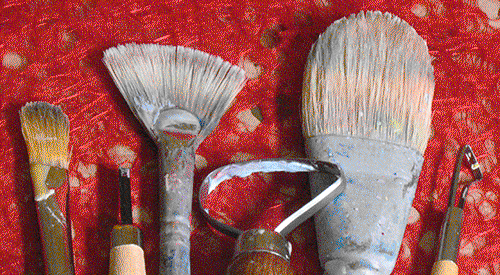
All artists have their favorite tools, but for basic encaustic painting this is a good list to start with:
A support that is rigid and absorbent. Wood or hardboard panels work well, but if you want to start with a white ground, Ampersand Encausticbord is a popular choice.
Hot palette. A pancake griddle, skillet or crock pot keeps the paint liquid while you work.
Encaustic paint. You can mix your own or buy it ready-made. See the chapter on for details on this.
Metal tins. Tuna or cat food cans work well to hold your paint, or you can melt the paint right on the hot palette.
Scraping and incising tools. A basic set of pottery tools with a variety of scrapers will get you started.
Brushes. Natural bristle brushes are a good choice and will hold up well to the heat. The least expensive 1 and 2 hog bristle brushes from a hardware store will work for most basic applications. For detail work youll want finer quality smaller brushes but as long as they are natural bristle it doesnt matter what medium they are made for.
Fusing tools. Most artists use a heat gun, small iron or a torch to fuse the paint to the support. Its a good idea to experiment with each one and see what method you prefer.
Thats it! There are always more materials and tools to try, but this will get you started.
Safety
Lets talk about a few safety tips before we get too far into this. Ill cover more throughout the book, but here are a few essentials.
Obviously youre working with molten wax so be sure you work in a safe area where children and pets wont hurt themselves. I always have a fire extinguisher handy, but by being careful Ive never had to use one. You probably wont need to either if you are aware of your materials and never leave your wax unattended, but its up to you to know your limits.
I think its essential to have some ventilation in your workspace regardless of the medium you use, and working with encaustic is no exception. For many spaces a simple fan in the window will be enough, but be sure the fan is pushing air out, not pulling air in. Visit my Resources page for more information on ventilation options. Also, keeping your griddle at around 200 degrees Fahrenheit (93 Celsius) or below will reduce the fumes generated by heating your wax.

